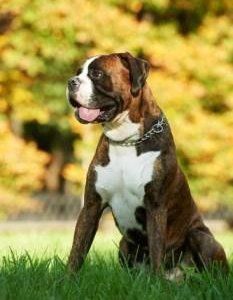Boxer Dog Training
Overview
Every dog should be trained in basic commands. This will make life easier for both owner and Boxer. Knowing these simple, yet important training commands will help keep your dog safe, keep your dog under control and limit chaos.
While most dogs can be trained at any age, there are instances when an owner may need to provide professional dog training. A dog with a very stubborn behavior or a previously neglected dog that spent years without any guidance may benefit from professional training.
You may begin training your Boxer dog these basic commands when the dog is 2 months old. No matter what age you dog, new tricks and training can be instilled...even an old dog can learn new tricks!
Come
This is such a simple command, but should not be overlooked. It is extremely important that your Boxer understand this command. It will be needed in many circumstances and will most likely - at some point - keep your dog from running into a dangerous predicament.
To train your dog to come at command, keep your Boxer on a long leash or with you in an enclosed area. Move 5 to 6 steps away from him and then call out the command. The command word should be "Come" (not 'come here' or any other variation).
Simply calling his name should be for more informal circumstances...This command means that you are serious. A long sentence, such as "Come here Roxy, over here!" is too long for a dog. You will want your dog to immediately come to you with 1 word.
Say the command word, kneel down and make a motion for your Boxer to come over to you. Reward him with a small treat. Your words of praise and happiness will make the biggest impression. Dogs love to please their owners. If you behave as if your dog just performed the most wonderful act, he will be more likely to repeat it.
Work on this command from further and further away. Once your Boxer understands this word and shows a good ability to listen to you, move on to other locations that are not so familiar. The goal is to have your dog listen to this command, no matter where you are.
What could make training for this command difficult? If - outside of training - you call your dog to come to you and then reprimand him or her in a negative way.
For example, if your dog has had a housebreaking accident, never use this command to speak negatively to him. "Come" should always imply that you will be happy.
Sit
A well behaved dog that listens to you makes for a more peaceful household. Directing your dog to "Sit" is an important command. You may need to use this command when visitors arrive at your home and many other occasions.
Training a Boxer dog in regard to the Sit command will be begin by bringing your dog into a room without distractions. Have a treat in your hand. Hold the dog treat a bit above his nose. As he notices the treat, move your hand straight across his back.
This usually makes the dog sit as he tries to follow where the treat went. If your dog does not completely sit, use your other hand to press down on his rear until he is in a complete sitting position. At that time, firmly say the command word "Sit".
It will be your job to make sure that your Boxer understands that what he is doing has a corresponding word. At the very moment
a dog completes an action and is in the desired position, a treat should be given. You'll want to be quick...
if a dog begins to rise when the reward is offered, he will not understand if the reward was for sitting or rising.
It is also important to incorporate the command word with the praise as it reinforces the learning. You will want to say "Good Sit" or "Good - fill in the blank with the command word".
As you work on this training, you should be able to back away from your Boxer and give the command from across the room. After a while, your dog should follow your command without needing a treat.
After 20 to 30 successful repetitions, the action becomes automated with no expected treat; though praise will help reinforce the behavior of following commands. A "Good boy!" or "Good girl!" from his Alpha human means quite a bit to a Boxer dog.
Heel
If you assume you will always be walking your Boxer on a leash and do not need to teach him the "Heel" command, think again! Did you ever see someone being walked by their dog? You should not be behind him or her, essentially allowing them to lead the way. Your dog should be by your side, walking together in tandem.
When you walk with your Boxer, as he grows from cute little puppy to a large and strong dog, you will want your dog to walk with you. Walks will not be pleasant if your Boxer is trying to pull you along the street. With you in control, you should be going at your
pace and taking corners or moving around obstacles in the direction that you choose.
Begin by having your dog on a short leash. Hold a treat in your hand. Say the command word, "Heel". Begin walking. Take 6 or 7 steps. If your dog walks nicely beside you, stop and give him the treat. Say words of praise that include the command word such as, "Good dog, you learned to heel".
Whenever your Boxer does not walk along side you, do not give him the treat. You must stop walking, allow the dog a moment to recoup and begin again.
As time goes on, your goal will be to be able to take more and more steps before giving the treat. Always use the command word.
If your Boxer has learned to walk with you for quite a distance, repeat the word in a pleasant tone as the 2 of you stroll down the street.
Give an occasional treat and certainly give words of praise. A dog can never receive enough positive reinforcement.
Related:
My Boxer dog won't listen to me
- Reasons for defiance and steps you can take to teach proper hierarchy.


